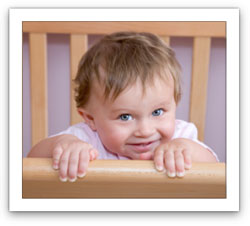Article at a Glance
• New federal safety standards ban the manufacture or sale of drop-side cribs; require a higher standard for hardware, mattress supports, and crib slats; and demand more rigorous safety testing.
• To find out if your crib meets the new guidelines, check to see if the tags include the code “16 CFR 1219” for full-size cribs and “16 CFR 1220” for compact-size cribs.
• Items like blankets, pillows, puffy bumpers, and stuffed animals can be a suffocation hazard when placed in your baby’s crib.

Crib related deaths and injuries have prompted the U.S. Consumer Product Safety Commission to step in with more rigorous safety standards for new cribs. As of June 28th, all new cribs that are manufactured or sold need to meet new federal safety standards:
• Traditional drop-side cribs cannot be made or sold; immobilizers and repair kits are not allowed.
• Wood slats must be made of stronger woods to prevent breakage.
• Crib hardware must have anti-loosening devices to keep it from coming loose or falling off.
• Mattress supports must be more durable.
• Safety testing must be more rigorous.
The new standards are meant to prevent dangerous gaps from occurring in cribs where babies could get trapped and suffocate. A study published in the journal Pediatrics this March found that on average 26 children under the age of two are injured while in a crib, playpen, or bassinet each day in the U.S.
What Does This Mean For You?
• Parents should get rid of cribs that are no longer compliant by disposing of them in a way that prevents them from being used. Do not try to resale or donate them.
• To find out if your crib meets the new guidelines, check to see if the tags include the code “16 CFR 1219” for full-size cribs and “16 CFR 1220” for compact-size cribs.
• Child care facilities, family child care homes, churches, motels, and similar organizations must use cribs that meet the new safety standards. They have until December 28, 2012 to comply. As a parent you should make sure management is aware of the new standards and that your baby is not using a recalled crib.
• If you decide not to buy a crib that meets the new standards, you will want to make sure your crib hasn’t been recalled by checking www.cribsafety.org. If your crib hasn’t been recalled and you continue to use it, it is very important to check the crib frequently for any loose hardware or broken or missing parts. If you have a drop-side crib, stop using that function and request an immobilizer from the manufacturer.
What Else You Need to Know About Crib Safety
• Things like pillows, blankets, puffy bumpers, stuffed animals, and mobiles can be suffocation hazards for babies under 12 months old. Both the American Academy of Pediatrics (AAP) and the Consumer Product Safety Commission (CPSC) advise against their use—warning that they can obstruct a baby’s nose and mouth. If this happens, young babies might not wake up enough to clear their airway.
• If you decide to use a bumper, the CPSC and the AAP strongly advise against using the puffy kind. Also make sure that they are tightly secured to the crib. Some consumer groups urge parents not to use any crib bumpers at all.
• Instead of blankets, use a blanker sleeper or zippered sleeper outfit. If you swaddle your baby, make sure the swaddling is tight and doesn’t come up above the arms.
• In 2010, CPSC and the FDA warned consumers against the use of sleep positioners or positioning pillows. There is no data showing that the positioners reduce the risk of SIDS and since 1997 they have contributed to the deaths of at least 13 babies.
• Keep cords, ribbons, or strings out of the crib. This includes power cords for baby monitors. Anything with a power cord should be placed well out of baby’s reach. Do not use low-hanging mobiles.
• According to the statistics the safest place for babies to sleep for the first six months is in the room with their parents in a separate crib or bassinet. Experts theorize that the baby and parents synchronize their breathing when sleeping close to each other, reducing the risk of SIDS. However experts warn that babies who sleep in their parents’ bed can suffocate in the bedding or be crushed. Bed-side sleepers are also not entirely safe because babies can become trapped between the sleeper and bed mattresses. There are several models that the CPSC has recalled because of this problem.
For More Information:
Consumer Product Safety Commission
When a Cuddly Crib Puts the Baby in Danger (Wall Street Journal)